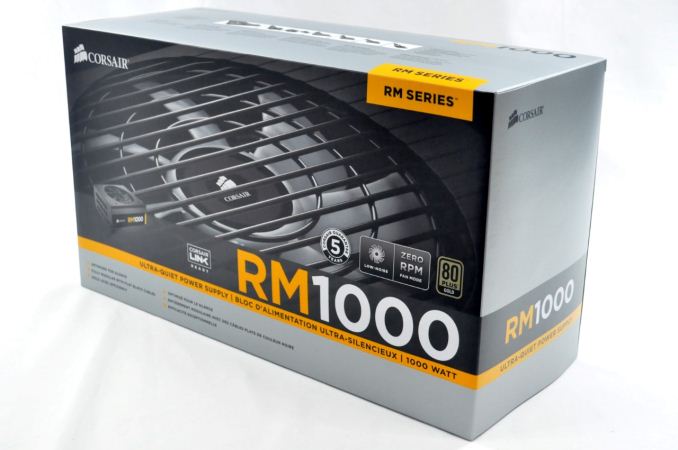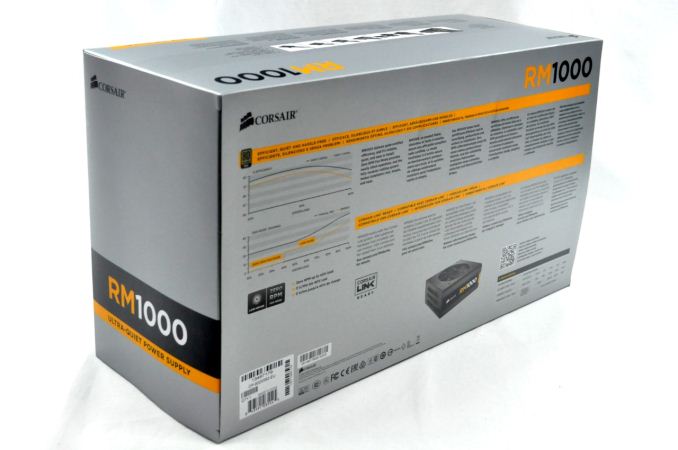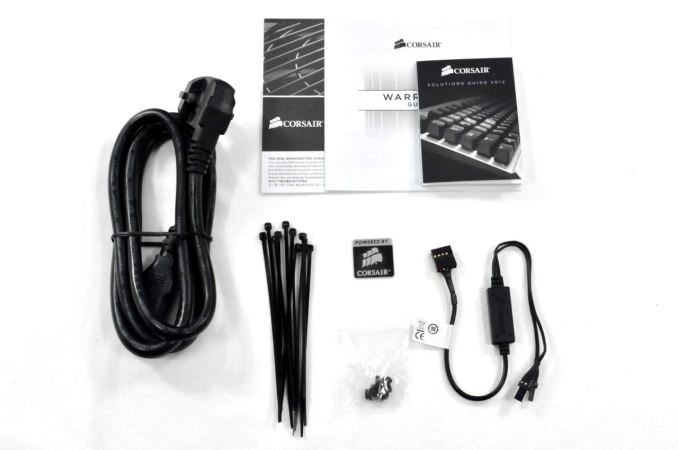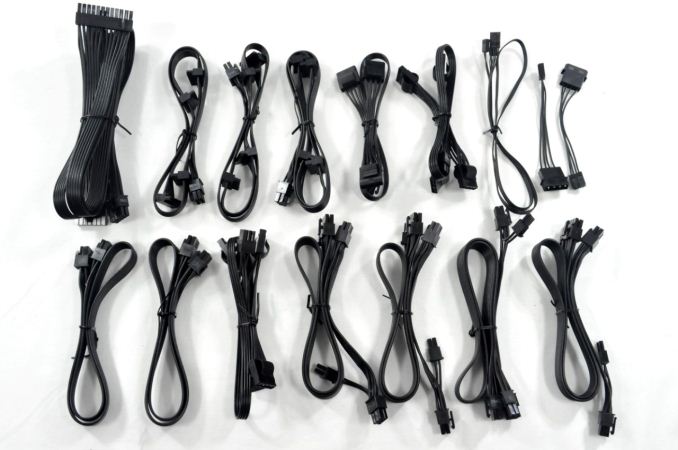Corsair RM1000 Power Supply Review
by E. Fylladitakis on April 24, 2014 6:00 AM EST- Posted in
- Cases/Cooling/PSUs
- Corsair
- PSUs
- RM Series

Introduction
Corsair has created a good reputation for their branded PSUs, and today they are among the most popular choices for gamers and enthusiasts. The first PSU from Corsair to find its way into our new testing lab is the RM1000, an 80 Plus Gold Certified unit with a rated output of 1000W at 40°C ambient. Given the rated power output and retail price of $169.99 after rebate, the RM1000 is understandably targeted at advanced users and gamers, and very few PCs require so much power. The target audience can be quite demanding, however, and a simple 80 Plus Gold certification is not enough to entice such users, so let's see what else Corsair has up their sleeves.
The RM series PSUs are optimized for silence and there are currently six models, ranging from 450W to 1000W. That makes the RM1000 the most powerful model of the series but it also is significantly different from the less powerful models as well. In fact, it's almost entirely different. The 750W and the 850W models come from a different ODM, as they are based off of Chicony Electronics designs, while Channel Well Technologies (CWT) supplies the other four models. As such, the RM1000 and the RM450/RM550/RM650 are all based on a CWT design, yet the RM1000 we're looking at is based on a different platform than that of the lower wattage models.
Corsair has had many CWT derived designs in the past and most of them were very popular among advanced users. However, times have changed and there is stiff competition in the market right now, especially in this particular segment, as every single manufacturer apparently wants a high performance 1000W model as their halo product, and the market has been virtually flooded with such PSUs. Not surprisingly, it's no longer possible to compete at the top of the market by simply offering a "high performance" PSU. Let's have a thorough look at the RM1000 and see what it can offer to consumers and where it falls short.
Packaging and bundle
We received the Corsair RM1000 inside a large, interestingly designed cardboard box. Most of the box is grey with yellow colored accents, the series' trademark. The front and sides of the box are relatively tidy, with badges and summarized descriptions of the most important features. The rear of the box offers a wealth of information regarding the performance of the power supply, summarized in charts and a table rather than tons of marketing text.
The Corsair RM1000 bundle is adequate, but it could have been better for a unit of this class. Alongside the power cord, manual and screws, Corsair also supplies a few cable ties, a case badge with the company's logo, a Corsair Link interface cable, and an advertising leaflet.
As this is a high output, fully modular unit, numerous cables are supplied alongside the PSU. All of the cables, including the ATX connector, are black ribbon cables without sleeving. Some will say they look significantly better than sleeved color-coded wires and require less space, though that's a matter of personal preference. while it looks like Corsair chose not to include a bag for the extra cables, the body of the unit itself comes wrapped inside a pouch for protection during shipping, and this pouch can be used to store the cables later on.














55 Comments
View All Comments
khanov - Saturday, April 26, 2014 - link
You can turn off the fanless mode on Seasonic's PSUs. That'd be a good option for Corsair to adopt I think.As for the Teapo comment, surely you cannot be serious. Teapo electrolytics as filters are a terrible option. They rarely last even half their rated lifetime. I replace Teapos quite a lot in consumer electronics devices (TVs, set top boxes, DVRs etc). They seem to go about 5 years on average before they fail with open vents.
The real problem when you go lower than first tier Japanese is that the manufacturers will sometimes straight up lie on their spec sheets. So they look like they should perform just as well on paper, but they never meet that performance in real applications unless treated much more gently than their specs would suggest. Ripple current (real vs rated) is one area where I see a lot of this happening and Teapo is one of the culprits.
YoloPascual - Friday, April 25, 2014 - link
I know your work for Corsair now jonny. Don't worry many ppl will still buy your incompetent psu because most of the people knows that if a psu has corsair sticker, it must be excellent.And no japanese caps are not over-rated actually they are under-rated. I got a Delta made psu from 1999 running like champ. It has a combination of Rubycons and Nippon-Chemicon.
royalcrown - Monday, April 28, 2014 - link
Come on! You act like Corsair sells dog poop. Whether or not you like them, they are not junk either. Calling it incompetent just reeks epeen elitism...just4U - Saturday, April 26, 2014 - link
What I really dislike about the RM line is they are very close in price to the HX series that was made by seasonic. (A company I trust) I expected these to be made by them.. but nope. Ticks me off.. I like Corsair branded Seasonics.. their the only ones I will buy, period. If Corsair is moving away from them.. then I am moving away from Corsair.Harald - Monday, May 5, 2014 - link
Actually, there was only ever one HX model made by Seasonic and that was the first revision of the HX650. I have the HX750 which is made by CWT, it's going on 4 and half years old and working like a charm.Harald - Monday, May 5, 2014 - link
(Sorry, forgot about the HX520 and 620)khanov - Friday, April 25, 2014 - link
+1 from me too.I'd have to skip this and go straight for an all Japanese-capped unit.
Also, are you sure there aren't any Ltec caps int here? I can't see well enough, but those green filters on the secondary side look suspiciously like the worst caps money can buy.
sor - Friday, April 25, 2014 - link
I didn't see the voltage being tested. usually there's a 2-3% efficiency gain at 220-240VJASTECH - Friday, April 25, 2014 - link
I have a 1050w modular, don't recall brand, I bought before my surgery then ressesitated, ICU then on O2 24/7. So its been a few years sense my purchase, anyways, out of the box hooked up not working. Tested it, seems a 5vdc not working. Quality PSU is DOA, so QC is still lacking.meacupla - Saturday, April 26, 2014 - link
YES to ribbon cables. More PSUs should come with this, as it is superior to braided sleeving and individual strands in terms of routing and bundling.NO to right angle SATA connectors! The cable lengths end up being wrong anyways and there is extreme strain on the cable where the pins bite into the wire. The cable just doesn't bend as smoothly as daisy-chained straight connectors.